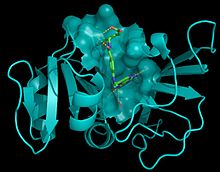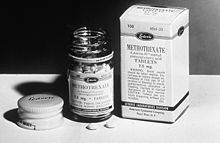Methotrexate
 | |
 | |
| Clinical data | |
|---|---|
| Pronunciation | /ˌmɛθəˈtrɛkˌseɪt, ˌmiː-, -θoʊ-/ ⓘ[1][2][3] |
| Trade names | Trexall, Rheumatrex, Otrexup, others[4] |
| Other names | MTX, amethopterin |
| AHFS/Drugs.com | Monograph |
| MedlinePlus | a682019 |
| License data |
|
| Pregnancy category |
|
intrathecal | |
| ATC code | |
| Legal status | |
| Legal status | |
Hepatic and intracellular[6] | |
| Elimination half-life | 3–10 hours (lower doses), 8–15 hours (higher doses)[6] |
| Excretion | Urine (80–100%), feces (small amounts)[6][7] |
| Identifiers | |
| |
JSmol) | |
| |
| |
| (verify) | |
Methotrexate (MTX), formerly known as amethopterin, is a
Common side effects include nausea, feeling tired, fever, increased risk of infection,
Methotrexate was first made in 1947 and initially was used to treat cancer, as it was less toxic than the then-current treatments.
Medical uses
Chemotherapy
Methotrexate was originally developed and continues to be used for chemotherapy, either alone or in combination with other agents. It is effective for the treatment of a number of cancers, including solid tumours of breast, head and neck, lung, bladder, as well as acute lymphocytic leukemias, non-Hodgkin's lymphoma, osteosarcoma, and choriocarcinoma and other trophoblastic neoplasms.[4][14]
Autoimmune disorders
Although originally designed as a chemotherapy drug, in lower doses methotrexate is a generally safe and well-tolerated drug in the treatment of certain autoimmune diseases.
Methotrexate is used as a disease-modifying treatment for a number of autoimmune diseases in adults, including rheumatoid arthritis,[15] psoriasis and psoriatic arthritis, reactive arthritis, enteropathic arthritis, myositis, systemic sclerosis, lupus, sarcoidosis, Crohn's disease,[16][17] eczema and many forms of vasculitis. In children, it can be used for juvenile dermatomyositis, juvenile idiopathic arthritis, uveitis and localised scleroderma.[18][19][20]
Methotrexate is one of the first-line therapies for the treatment of rheumatoid arthritis. Weekly doses of 5 to 25mg were found by a Cochrane review to be beneficial for 12-52 weeks duration of therapy, though it is used longer-term in clinical practice. Discontinuation rates are as high as 16% due to adverse effects.[21][18][22][23]
Use of low doses of methotrexate together with NSAIDs such as aspirin or analgesics such as paracetamol is relatively safe in people being treated for rheumatoid arthritis, with appropriate monitoring.[24] Methotrexate is also sometimes used in combination with other conventional DMARDs, such as sulfasalazine and hydroxychloroquine.[25]
Studies and reviews have found that most rheumatoid arthritis patients treated with methotrexate for up to one year had less pain, functioned better, had fewer swollen and tender joints, and had less disease activity overall as reported by themselves and their doctors[citation needed]. X-rays also showed that the progress of the disease slowed or stopped in many people receiving methotrexate, with the progression being completely halted in about 30% of those receiving the drug.[26] Those individuals with rheumatoid arthritis treated with methotrexate have been found to have a lower risk of cardiovascular events such as myocardial infarctions and strokes.[27]
Results of a systematic review exploring the comparative effectiveness of treatments of early rheumatoid arthritis show that treatment efficacy can be improved with combination therapy with anti-TNF or other biologic medications, compared with methotrexate monotherapy.[15][28]
Likewise, a 2016 study found the use of methotrexate, in combination with anti-TNF agents, has been shown to be effective for the treatment of ulcerative colitis.[29]
Methotrexate has also been used for multiple sclerosis[4] and is used occasionally in systemic lupus erythematosus, with tentative evidence to support such use.[30]
During pregnancy
Methotrexate is an abortifacient and is used to treat ectopic pregnancies, provided the fallopian tube has not ruptured.[4][31] Methotrexate with dilation and curettage is used to treat molar pregnancy. Rarely, it is used in combination with mifepristone to abort uterine pregnancies.[32]
Administration
Methotrexate can be given by mouth or by injection (
Folic acid is commonly co-prescribed with methotrexate to minimise the risk of adverse effects.[20]
Adverse effects
The most common adverse effects include hepatotoxicity, stomatitis, blood abnormalities (leukopenia, anaemia and thrombocytopenia), increased risk of infection, hair loss, nausea, reduced appetite, abdominal pain, diarrhea, fatigue, fever, dizziness, drowsiness, headache, acute pneumonitis and renal impairment.[4][18][33][14] Methotrexate can also cause mucositis.[34]
Methotrexate pneumonitis is a rare complication of therapy, and appears to be reducing in frequency in most recent rheumatoid arthritis treatment trials.[35] In the context of rheumatoid arthritis interstitial lung disease, methotrexate treatment may be associated with a lower incidence of ILD over time.[citation needed]
Methotrexate is teratogenic and it is advised stop taking it at least 4 weeks before becoming pregnant and it should be avoided during pregnancy (pregnancy category X) and while breastfeeding.[36] Guidelines have been updated to state that it is safe for a male partner to take at any point while trying to conceive.[37]
Central nervous system reactions to methotrexate have been reported, especially when given via the intrathecal route (directly into the cerebrospinal fluid), which include myelopathies and leukoencephalopathies. It has a variety of cutaneous side effects, particularly when administered in high doses.[38]
Another little understood but serious possible adverse effect of methotrexate is neurological damage and memory loss.[39] Neurotoxicity may result from the drug crossing the blood–brain barrier and damaging neurons in the cerebral cortex. People with cancer who receive the medication often nickname these effects "chemo brain" or "chemo fog".[39]
Drug interactions
Other immunosuppressants like cyclosporins may potentiate methotrexate's haematologic effects, hence potentially leading to toxicity.[40] NSAIDs have also been found to fatally interact with methotrexate in numerous case reports.[40] Nitrous oxide potentiating the haematological toxicity of methotrexate has also been documented.[40]
Mechanism of action


Methotrexate is an
For the treatment of rheumatoid arthritis, inhibition of DHFR is not thought to be the main mechanism, but rather multiple mechanisms appear to be involved, including the inhibition of enzymes involved in
History

In 1947, a team of researchers led by
In 1951,
References
- OxfordDictionaries.com. Archived from the originalon 22 October 2012. Retrieved 20 January 2016.
- ^ "methotrexate". Merriam-Webster.com Dictionary.
- ^ "methotrexate". Dictionary.com Unabridged (Online). n.d.
- ^ a b c d e f g h i j k l m n o p q r s t u v w "Methotrexate". The American Society of Health-System Pharmacists. Archived from the original on 8 October 2016. Retrieved 22 August 2016.
- FDA. Retrieved 22 October 2023.
- ^ a b c d e "Trexall, Rheumatrex (methotrexate) dosing, indications, interactions, adverse effects, and more". Medscape Reference. WebMD. Archived from the original on 8 February 2014. Retrieved 12 April 2014.
- ^ S2CID 46974070.
- ISBN 9780470015520. Archivedfrom the original on 16 February 2017.
- ^ "Today's anti-cancer tools are ever better wielded". The Economist. 14 September 2017. Retrieved 16 September 2017.
- hdl:10665/325771. WHO/MVP/EMP/IAU/2019.06. License: CC BY-NC-SA 3.0 IGO.
- hdl:10665/345533. WHO/MHP/HPS/EML/2021.02.
- ^ "The Top 300 of 2021". ClinCalc. Archived from the original on 15 January 2024. Retrieved 14 January 2024.
- ^ "Methotrexate - Drug Usage Statistics". ClinCalc. Retrieved 14 January 2024.
- ^ a b "Methotrexate 2.5 mg Tablets - Summary of Product Characteristics (SmPC) - (emc)". www.medicines.org.uk. Retrieved 19 February 2023.
- ^ PMID 30199187.
- PMID 23295701.
- S2CID 25311594.
- ^ ISBN 978-0-9805790-9-3.
- ISBN 978-0-85711-084-8.
- ^ a b "Methotrexate". Versus Arthritis. Retrieved 19 February 2023.
- PMID 24916606.
- S2CID 1643606.
- PMID 11840435.
- PMID 22071858.
- ^ "Methotrexate and its use in rheumatoid arthritis (RA)". NRAS. Retrieved 19 February 2023.
- PMID 23874006.
- PMID 22850632.
- PMID 31388915.
- PMID 26981630.
- S2CID 36049926.
] To date, three small [86–88] RCTs in SLE patients have been published, including in total 76 patients in the active arm
- PMID 18522946.
- ^ "Medical abortion - Mayo Clinic". www.mayoclinic.org. Retrieved 10 July 2022.
- ^ "BNF is only available in the UK". NICE. Retrieved 19 February 2023.
- S2CID 6273303.
- PMID 31709258.
- PMID 21044438.
- PMID 36318965.
- PMID 17459301.
- ^ S2CID 9456346.
- ^ a b c d e f g Brayfield A, ed. (6 January 2014). "Methotrexate". Martindale: The Complete Drug Reference. Pharmaceutical Press. Retrieved 12 April 2014.
- ^ PMID 12359872.
- PMID 10476546.
- PMID 18045808.
- PMID 15194170.
- S2CID 25311594.
- ISBN 978-3-7643-5959-1.[page needed]
- PMID 14777272.
- PMID 14850976.
- S2CID 22939197.
- PMID 13786791.
- PMID 14202592.
External links
- Methotrexate Injection MedlinePlus article from NIH
